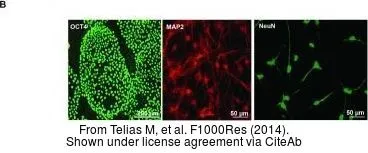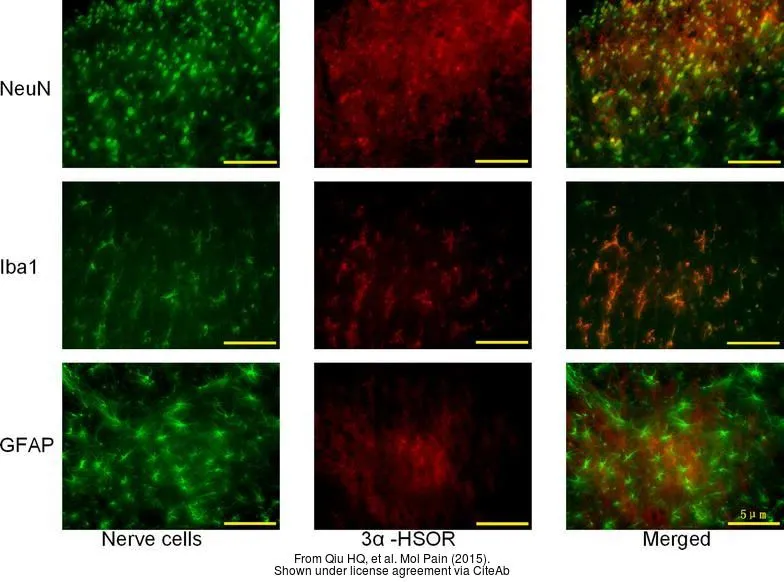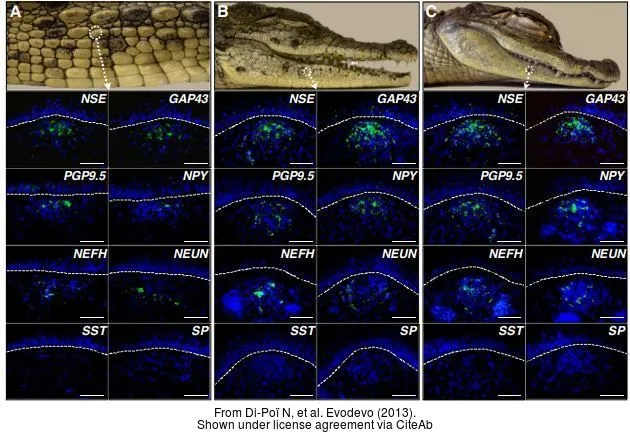![IHC-P analysis of mouse brain tissue (dentate gyrus and subventricular zone) using GTX30773 NeuN antibody [2Q158]. Red : Primary antibody Green : BrdU IHC-P analysis of mouse brain tissue (dentate gyrus and subventricular zone) using GTX30773 NeuN antibody [2Q158]. Red : Primary antibody Green : BrdU](https://www.genetex.com/upload/website/prouct_img/normal/GTX30773/GTX30773_20191203_IHC-P_17_w_23060722_447.webp)
IHC-P analysis of mouse brain tissue (dentate gyrus and subventricular zone) using GTX30773 NeuN antibody [2Q158]. Red : Primary antibody Green : BrdU
NeuN antibody [2Q158]
GTX30773
ApplicationsImmunoFluorescence, Western Blot, ImmunoCytoChemistry, ImmunoHistoChemistry, ImmunoHistoChemistry Frozen, ImmunoHistoChemistry Paraffin
Product group Antibodies
TargetRbfox3
Overview
- SupplierGeneTex
- Product NameNeuN antibody [2Q158]
- Delivery Days Customer9
- Application Supplier NoteICC/IF: 1:10-1:100. IHC-P: 1:100. *Optimal dilutions/concentrations should be determined by the researcher.Not tested in other applications.
- ApplicationsImmunoFluorescence, Western Blot, ImmunoCytoChemistry, ImmunoHistoChemistry, ImmunoHistoChemistry Frozen, ImmunoHistoChemistry Paraffin
- CertificationResearch Use Only
- ClonalityMonoclonal
- Clone ID2Q158
- ConjugateUnconjugated
- Gene ID52897
- Target nameRbfox3
- Target descriptionRNA binding protein, fox-1 homolog (C. elegans) 3
- Target synonymsFox-3, Hrnbp3, NeuN, Neuna60, RNA binding protein fox-1 homolog 3, fox-1 homolog C, hexaribonucleotide binding protein 3, neuN antigen, neuronal nuclear antigen A60, neuronal nuclei antigen
- HostMouse
- IsotypeIgG1
- Protein IDQ8BIF2
- Protein NameRNA binding protein fox-1 homolog 3
- Storage Instruction-20°C or -80°C,2°C to 8°C
- UNSPSC12352203
References
- Schaefers C, Rothmiller S, Thiermann H, et al. The Efficiency of Direct Maturation: the Comparison of Two hiPSC Differentiation Approaches into Motor Neurons. Stem Cells Int. 2022,2022:1320950. doi: 10.1155/2022/1320950Read this paper
- Huang TL, Mei YW, Li Y, et al. Thrombospondin-2 promotes the proliferation and migration of glioma cells and contributes to the progression of glioma. Chin Neurosurg J. 2022,8(1):39. doi: 10.1186/s41016-022-00308-xRead this paper
- Wu C, Xu G, Bao G, et al. Ubiquitin ligase Triad1 promotes neurite outgrowth by inhibiting MDM2-mediated ubiquitination of the neuroprotective factor pleiotrophin. J Biol Chem. 2022,298(10):102443. doi: 10.1016/j.jbc.2022.102443Read this paper
- Wei J, Liu H, Liu Z, et al. The Temporal and Spatial Changes of Th17, Tregs, and Related Cytokines in Epilepsy Lesions. Appl Bionics Biomech. 2022,2022:7871302. doi: 10.1155/2022/7871302Read this paper
- Xiang P, Hu J, Wang H, et al. miR-204-5p is sponged by TUG1 to aggravate neuron damage induced by focal cerebral ischemia and reperfusion injury through upregulating COX2. Cell Death Discov. 2022,8(1):89. doi: 10.1038/s41420-022-00885-xRead this paper
- Zhang K, Lu WC, Zhang M, et al. Reducing host aldose reductase activity promotes neuronal differentiation of transplanted neural stem cells at spinal cord injury sites and facilitates locomotion recovery. Neural Regen Res. 2022,17(8):1814-1820. doi: 10.4103/1673-5374.330624Read this paper
- Fei H, Xiang P, Luo W, et al. CTRP1 Attenuates Cerebral Ischemia/Reperfusion Injury via the PERK Signaling Pathway. Front Cell Dev Biol. 2021,9:700854. doi: 10.3389/fcell.2021.700854Read this paper
- Zhao M, Gao J, Zhang Y, et al. Elevated miR-29a Contributes to Axonal Outgrowth and Neurological Recovery After Intracerebral Hemorrhage via Targeting PTEN/PI3K/Akt Pathway. Cell Mol Neurobiol. 2021,41(8):1759-1772. doi: 10.1007/s10571-020-00945-9Read this paper
- Lin CT, Lecca D, Yang LY, et al. 3,6'-dithiopomalidomide reduces neural loss, inflammation, behavioral deficits in brain injury and microglial activation. Elife. 2020,9. doi: 10.7554/eLife.54726Read this paper
- Hsu WH, Shiao YJ, Chao YM, et al. T1-11, an adenosine derivative, ameliorates aging-related behavioral physiology and senescence markers in aging mice. Aging (Albany NY). 2020,12(11):10556-10577. doi: 10.18632/aging.103279Read this paper

![IHC-P analysis of rat cerebellum tissue using GTX30773 NeuN antibody [2Q158].Immunoreactivity is seen as nuclear staining in the neurons in the granular layer. Antigen retireval : Citrate Buffer, pH 6.0 Dilution : 1:100 IHC-P analysis of rat cerebellum tissue using GTX30773 NeuN antibody [2Q158].Immunoreactivity is seen as nuclear staining in the neurons in the granular layer. Antigen retireval : Citrate Buffer, pH 6.0 Dilution : 1:100](https://www.genetex.com/upload/website/prouct_img/normal/GTX30773/GTX30773_20191203_IHC-P_29_w_23060722_654.webp)
![IHC-P analysis of mouse brain tissue (dentate gyrus and subventricular zone) using GTX30773 NeuN antibody [2Q158]. Red : Primary antibody Green : BrdU Antigen retireval : Citrate Buffer, pH 6.0 IHC-P analysis of mouse brain tissue (dentate gyrus and subventricular zone) using GTX30773 NeuN antibody [2Q158]. Red : Primary antibody Green : BrdU Antigen retireval : Citrate Buffer, pH 6.0](https://www.genetex.com/upload/website/prouct_img/normal/GTX30773/GTX30773_20191203_IHC-P_30_w_23060722_656.webp)



